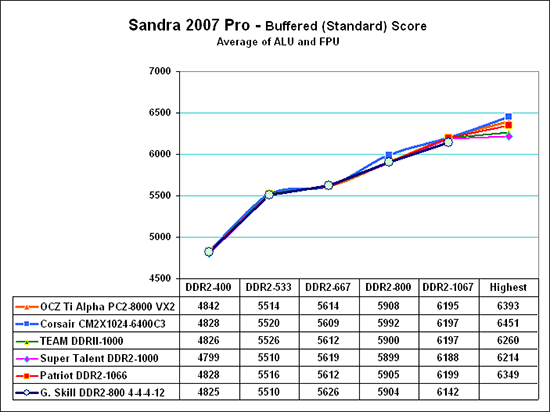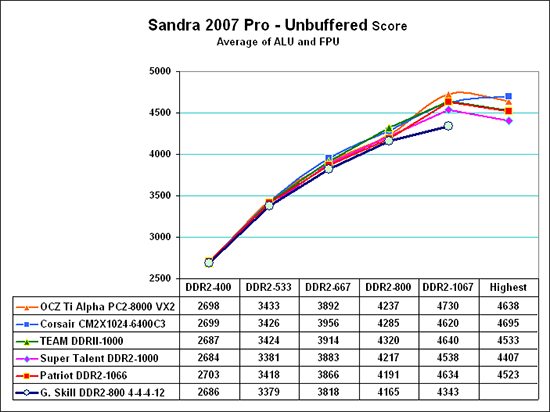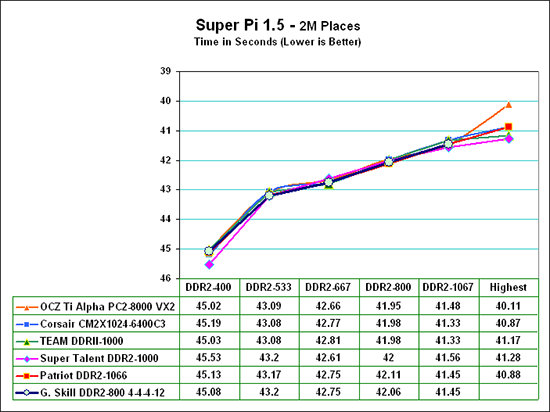Memory Bandwidth Scaling
Memory bandwidth normally improves with increases in memory speed and reductions in memory timings. This is best illustrated using Performance Scaling charts instead of the bar charts for individual speeds that were used in past memory reviews.
Since the results for high-end memory were so close at all tested speeds, the scale range was reduced to better show the small differences in these memory benchmark results. Please keep this in mind when viewing the charts, since a normal zero scale would make performance differences appear much smaller than these expanded scale charts. Maximum values for other memories at each speed are included in each chart for reference.
To evaluate memory bandwidth SiSoft Sandra 2007 Professional was used to provide a closer look at scaling for fast DDR2 memory.

The most widely reported Sandra score is the Standard or Buffered memory score. This benchmark takes into account the buffering schemes like MMX, SSE, SSE2, SSE3, and other buffering tools that are used to improve memory performance. Buffered bandwidth performance of the G.Skill memory was virtually the same as the previously tested high-end DDR2 memory to DDR2-800. Performance does drop a bit at DDR2-1066 due to the slower timings required of the mid-range G.Skill memory.
The Buffered benchmark does not correlate well with real performance differences in games, so our memory bandwidth tests have always included an Unbuffered Sandra memory score. The Unbuffered result turns off the buffering schemes, and we have found the difference in Unbuffered results correlate well with real-world performance differences.

In Unbuffered tests we see the G.Skill mirrors the best memory tested to DDR2-800. Performance does drop a bit if you run at slower timings and reduced voltage at DDR2-800. Again, at DDR2-1067, the penalty of 5-5-5 timings compared to 4-3-4 causes slightly lower results with the G.Skill. It is worth pointing out, however, that memory bandwidth, both buffered and Unbuffered, continues to increase with memory speed even though memory timings are a great deal slower at DDR2-1067.
We also compared results with Version 1.5 of Super Pi - comparing the time to calculate 2 million places of Pi at the different memory speeds. This benchmark measures pure number crunching.

Super Pi results continue to improve all the way to the highest speed that could be reached with stability with each memory. The second item that stands out is how very close the results with all the memories really are.. All 6 memories perform very similarly with just two exceptions. The G.Skill performs similarly until DDR2-1067 where slower timings finally provide a penalty. The Super Talent drops off a bit at the top and bottom due to slightly slower timings in those ranges. While performance is very close, Super Pi scaling charts continue to show the useful sensitivity of Super Pi as a measurement of memory performance
Memory bandwidth normally improves with increases in memory speed and reductions in memory timings. This is best illustrated using Performance Scaling charts instead of the bar charts for individual speeds that were used in past memory reviews.
Since the results for high-end memory were so close at all tested speeds, the scale range was reduced to better show the small differences in these memory benchmark results. Please keep this in mind when viewing the charts, since a normal zero scale would make performance differences appear much smaller than these expanded scale charts. Maximum values for other memories at each speed are included in each chart for reference.
To evaluate memory bandwidth SiSoft Sandra 2007 Professional was used to provide a closer look at scaling for fast DDR2 memory.

The most widely reported Sandra score is the Standard or Buffered memory score. This benchmark takes into account the buffering schemes like MMX, SSE, SSE2, SSE3, and other buffering tools that are used to improve memory performance. Buffered bandwidth performance of the G.Skill memory was virtually the same as the previously tested high-end DDR2 memory to DDR2-800. Performance does drop a bit at DDR2-1066 due to the slower timings required of the mid-range G.Skill memory.
The Buffered benchmark does not correlate well with real performance differences in games, so our memory bandwidth tests have always included an Unbuffered Sandra memory score. The Unbuffered result turns off the buffering schemes, and we have found the difference in Unbuffered results correlate well with real-world performance differences.

In Unbuffered tests we see the G.Skill mirrors the best memory tested to DDR2-800. Performance does drop a bit if you run at slower timings and reduced voltage at DDR2-800. Again, at DDR2-1067, the penalty of 5-5-5 timings compared to 4-3-4 causes slightly lower results with the G.Skill. It is worth pointing out, however, that memory bandwidth, both buffered and Unbuffered, continues to increase with memory speed even though memory timings are a great deal slower at DDR2-1067.
We also compared results with Version 1.5 of Super Pi - comparing the time to calculate 2 million places of Pi at the different memory speeds. This benchmark measures pure number crunching.

Super Pi results continue to improve all the way to the highest speed that could be reached with stability with each memory. The second item that stands out is how very close the results with all the memories really are.. All 6 memories perform very similarly with just two exceptions. The G.Skill performs similarly until DDR2-1067 where slower timings finally provide a penalty. The Super Talent drops off a bit at the top and bottom due to slightly slower timings in those ranges. While performance is very close, Super Pi scaling charts continue to show the useful sensitivity of Super Pi as a measurement of memory performance










30 Comments
View All Comments
Wesley Fink - Friday, November 3, 2006 - link
Yes, you can use dividers in overclocking. The ratios and underlying frequencies are more complicated than they appear on the surface, but we have shown in numerous memory reviews that the penalty for not running the preferred 1:1 is really pretty small.If cost is a constraint in a build then money put in a video upgrade first will deliver the most improvement in performance, a CPU would be the next place the upgrade yields great value. Higher memory speeds do increase performnace, but the increases are very small compared to a video card upgrade or a CPU upgrade.
Madellga - Saturday, November 4, 2006 - link
How do you run the memory slower?This was an option with the A64, but so far with the 965 chipset the options are to run the the memory faster, not slower.
My sample size is small, but both the Abit AW9D (975) and Gigabyte DS4 (965) don't have ratios to slow down the memory.
Wesley Fink - Saturday, November 4, 2006 - link
The memory may be RATED at DDR2-800, but you can select memory ratios to run the base at DDR2-400, 533, 667, 800, 1066 and sometimes in-between ratios. That allows you to set the memory at DDR2-400, for example, and overclock your CPU to much higher levels. This is how we test memory at different speeds. This feature is also available on almost every 975, 965, and AM2 board we have tested - except the very lowest models.For example, if I set my DDR2-800 to DDR2-533 (1:1 ratio) I can overclock my bus to 1600 (400 FSB) and then be at the specifed speed of DDR2-800. Remember the bus is quad-pumped on Intel - 266 is the base setting for 1067. Memory is DOUBLE dat tate, so DDR2-533 is a base setting of 266 - that is whay it is 1:1. So at a 400 setting bus speed is 1600 and memory is DDR2-800.
Madellga - Sunday, November 5, 2006 - link
Wes, thanks for the explanation. I've always used 1:1, when you mentioned using dividers I thought you meant something under 1:1.The A64 "dividers" were less confusing than Intel's memory straps, despite the fact how the divider was calculated.
vailr - Friday, November 3, 2006 - link
Any thought of running the memory tests under Windows XP x64? Do the Sandra benchmark tests run in the x64 operating system?Gary Key - Friday, November 3, 2006 - link
The Sandra benchmarks will run fine in XP-64. Once VISTA goes is RTM then we will be switching over to this OS. We had thought about doing some XP-64 tests when Conroe launched but decided to wait (and wait and wait and wait as it turns out) for VISTA.vailr - Friday, November 3, 2006 - link
Vista will also be offered in x64 and "x86" versions. Which version will be favored, as far as AT reviews & benchmark tests?Wesley Fink - Friday, November 3, 2006 - link
64-bit Vista is touted as the PRO version, with 32-bit Vista more akin to XP Home. Unless there are strong reasons otherwise the 64-bit version will likely be the standard.MxChris - Friday, November 3, 2006 - link
How is this different from this set: http://www.newegg.com/Product/Product.asp?Item=N82...">F2-6400CL4D-2GBPK that I bought a coule months ago? Looks to have exactly the same rated timings and specs according to newegg.Wesley Fink - Friday, November 3, 2006 - link
According to G. Skill specs, your memory is rated 1.9-2.0V at 4-4-4-12 and it is pictured with a pale blue heatspreader. Our test dimms are rated 2.0-2.1V for the same timings and have black heatspreaders. You will need to ask G. Skill if your dimms use different memory chips since we don't have samples available to check the chips used on your model number.Your G. Skill kit is curently selling for $240 at newegg compared to $299 for the kit we tested, so I suspect they are based on different memory chips. The Micron chips are notoriously expensive - even with slower bins -and we have seen Mosel used in some mid memory of late, as well as the Elpida that is normal for low-mid memory.